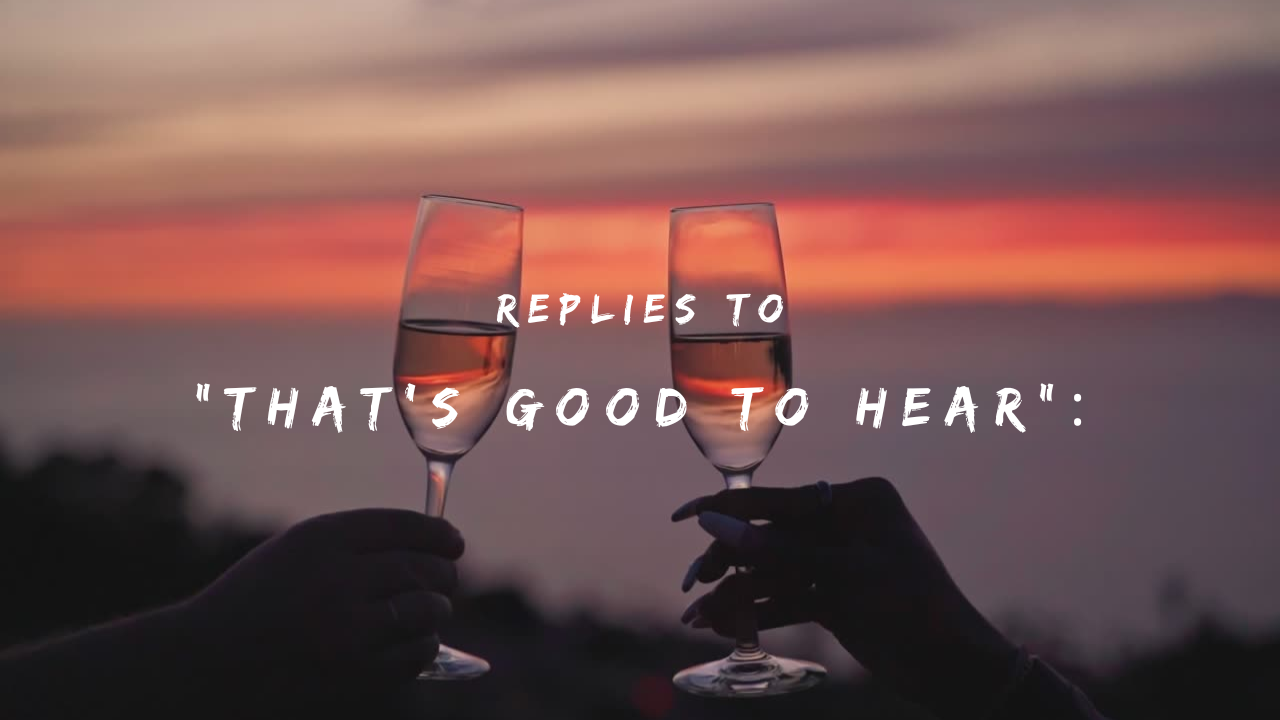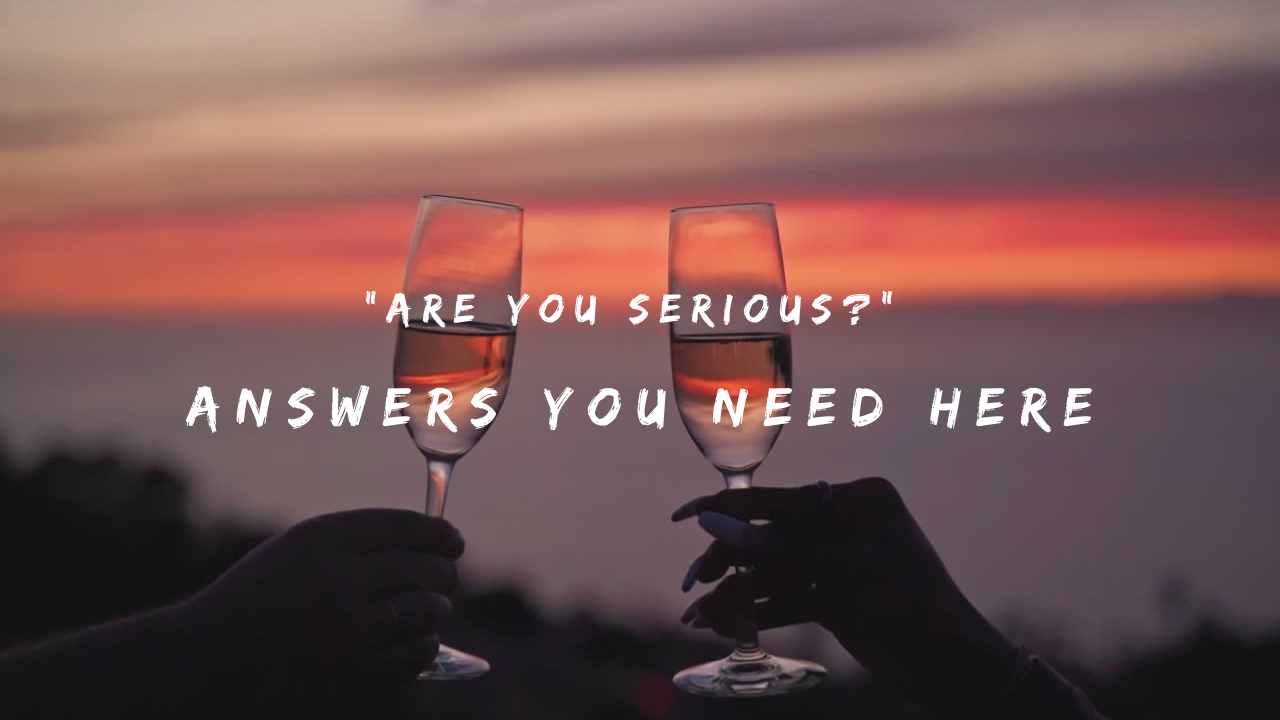We all know “That’s Good To Hear,” but do we always know the best way to reply? Whether you’re at work, catching up with friends, or talking to family, how you respond can shape the conversation and your relationships. Let’s dive into the nuances of crafting the perfect reply.

150+ Replies To “That’s Good To Hear”
Enthusiastic Agreement
- It’s fantastic news!
- I’m so glad to hear that!
- That’s music to my ears!
- I agree, it’s wonderful!
- I couldn’t have said it better myself!
- I’m thrilled you feel that way too!
- Yes, it’s uplifting news!
- You took the words right out of my mouth!
- That’s exactly what I was hoping for!
- It’s great to hear we’re on the same page!
Polite Acknowledgment
- Thank you for your positive feedback.
- I’m glad to hear you’re pleased.
- It’s nice to know you’re happy about it.
- I appreciate your response.
- Thank you for acknowledging that.
- I’m pleased you think so.
- It’s good to hear your approval.
- Thanks for the encouraging words.
- I’m happy to hear that you’re satisfied.
- I appreciate your support on this.
Request for More Information
- What specifically do you find good about it?
- Can you tell me more about why you think it’s good?
- Is there any particular detail that stands out?
- What are the key aspects that make it positive?
- Could you elaborate on what you mean?
- Do you have any further insights to share?
- What part of the news is most significant?
- Can you provide more details on this?
- What’s the impact of this news for us?
- Is there anything else we should know?
Seeking Confirmation
- So, we’re definitely on track?
- Does this mean everything is proceeding as planned?
- Are we aligned with our goals?
- Is this a sign that we’re meeting expectations?
- Can we take this as a positive indicator?
- Does this confirm we’re heading in the right direction?
- Are you saying everything is going smoothly?
- Is this the confirmation we were looking for?
- Does this indicate we’re making progress?
- Can we rely on this as a positive development?
Expressing Relief
- I’m relieved to hear that; it’s been a tense time.
- That’s a weight off my shoulders!
- I’m so glad to hear some good news after everything.
- What a relief—things are looking up!
- It’s such a relief to hear this!
- I’m happy to hear this after the recent challenges.
- That’s a comforting update.
- I’m relieved everything is turning out well.
- It’s reassuring to hear things are going well.
- That’s exactly the kind of news I needed!
Sharing Excitement
- I’m so excited about this—let’s celebrate!
- This is fantastic news; I’m thrilled!
- I’m pumped about this!
- This is just the kind of boost we needed!
- I’m over the moon about this!
- This is incredible; I can’t wait to see what’s next!
- I’m ecstatic to hear this—what a great outcome!
- This has made my day—so exciting!
- I’m buzzing with excitement about this!
- This news is just what we needed—so exciting!
Offering Support or Assistance
- If you need any help moving forward, just let me know.
- I’m here to assist with whatever you need.
- Let me know if there’s anything I can do to support you.
- Feel free to reach out if you need any help with this.
- If you have any questions or need further assistance, I’m available.
- I’m happy to help in any way I can.
- If there’s anything more I can do, just say the word.
- I’m here for you if you need any additional support.
- Let me know if you need any resources or help.
- I’m ready to assist with any next steps you might have.
Redirecting the Conversation
- What’s our next step now?
- Let’s move on to the next topic.
- What other updates do you have for us?
- Can we discuss the upcoming plans now?
- Let’s focus on the next phase of the project.
- What should we tackle next?
- Is there anything else we need to address?
- Let’s shift our attention to the next item on the agenda.
- What’s the next priority we should discuss?
- Do you have any other news to share?
Modest Reflection
- We’ve come a long way, but there’s still work ahead.
- It’s been a journey, and this is a great milestone.
- We’re making progress, and that’s encouraging.
- It’s nice to see things improving slowly.
- There’s more to do, but this is a step in the right direction.
- We’ve made strides, though there’s still room for growth.
- This is positive, but let’s keep up the effort.
- It’s a good sign, but let’s focus on our goals.
- It’s a step forward, and we’ll keep moving ahead.
- We’ve achieved something, but let’s continue pushing forward.
Expressing Gratitude
- Thank you for your positive feedback!
- I appreciate your encouraging words.
- Thanks for acknowledging the good news.
- I’m grateful for your support.
- Your positive response means a lot to me.
- Thank you for sharing the good news.
- I appreciate your kind words.
- Thanks for your continued support and positivity.
- I’m thankful for your encouragement.
- Your positive reaction is much appreciated.
Humorous Response
- Good news always makes my day better!
- Looks like we’re on a winning streak!
- I’m glad to hear that I was running out of positive things to say!
- This is great—my optimism levels are through the roof!
- I guess I’ll have to find a new way to celebrate!
- This kind of news makes me want to do a happy dance!
- Finally, some good news doesn’t require a coffee break!
- I’ll have to add ‘good news’ to my list of favourite things!
- Looks like my ‘good news’ playlist is working!
- If only all days were this cheerful!
Reflective Response
- Moments like these remind us of the progress we’ve made.
- Looking back, it’s satisfying to see how far we’ve come.
- It’s great to see positive results from our efforts.
- This makes all the hard work worth it.
- Reflecting on the journey, this is a significant step.
- It’s rewarding to see the positive outcome of our efforts.
- This news is a nice reflection of our progress.
- It’s fulfilling to see the results of our dedication.
- This reminds us of the value of perseverance.
- It’s gratifying to see our hard work paying off.
Encouraging Response
- Let’s keep the momentum going!
- This is a great start; let’s continue pushing forward.
- We’re on the right track—let’s build on this success.
- Keep up the great work; this is just the beginning!
- This is a fantastic outcome—let’s stay focused and keep achieving.
- We’ve made excellent progress; let’s maintain this positive trend.
- Let’s use this as motivation to keep striving for more.
- This is encouraging; let’s keep aiming high!
- Fantastic news—let’s keep up the effort!
- We’re doing great—let’s continue with this positive energy.
Sharing Personal Experience
- I had a similar experience, which also turned out well for me.
- This reminds me of a time when I saw similar positive results.
- I faced something like this before, and it was a great outcome.
- I can relate to this; seeing good results is always rewarding.
- I remember a time when things turned out just as well.
- I’ve been in a similar situation, and it was very positive.
- Your experience resonates with mine; I had a similar result.
- I’ve had a similar situation where things worked out well.
- This reminds me of a past success I had.
- I’ve been through something similar, and it was a great experience.
Clarifying Intentions
- Does this mean we’re ready to move forward with the next steps?
- How does this impact our upcoming plans?
- What should we focus on next based on this news?
- What are our immediate next actions after this update?
- How does this change our strategy moving forward?
- Can we take this as a cue for our next steps?
- What does this mean for our current goals?
- Is there anything specific we should address now?
- How should we adjust our plans based on this information?
- What are the implications of this news for our next phase?
Why a Good Reply Matters
How we reply to comments like “That’s Good To Hear” can significantly impact our interactions. It’s not just about being polite; it’s about enhancing communication and building rapport. A well-considered reply shows that you’re engaged and appreciative, which helps foster positive relationships.
Different Contexts for “That’s Good To Hear”
Understanding the context is crucial when responding. Whether in a professional setting, a casual chat, or a personal conversation, your reply should be tailored to fit the situation.
Tailoring Your Response Based on the News
Your reply should fit the type of news being shared.
- Good News
Expressing genuine happiness shows you’re engaged and positive.
- Neutral News
Keeping the conversation lively is key, even if the news isn’t particularly exciting.
- Bad News
Being supportive and empathetic can help comfort the person sharing disappointing news.
Common Mistakes to Avoid
- Overly Formal Replies in Casual Settings: Avoid sounding stiff or distant in informal conversations.
- Underwhelming Responses to Significant News: Don’t minimise important updates with lacklustre replies.
Examples of Inappropriate Replies
Replies that Come Off as Disinterested
- Example 1: “Oh, okay.” It can seem dismissive.
- Example 2: “That’s fine.” It may come across as unengaged.
Replies That May Seem Insincere
- Example 1: “That’s good, I guess.” Lacks genuine enthusiasm.
- Example 2: “Sure, whatever.” Sounds indifferent.
When to Ask Follow-Up Questions
If you want to show more interest, asking follow-up questions can help.
- Clarifying Details
If you need more information, asking politely can show you care.
- Showing Genuine Interest
Follow-up questions can help keep the conversation going and show you’re engaged.
Cultural Considerations
Different cultures have varying norms for responses. Being aware of these can help you navigate conversations more effectively.
- Different Cultures, Different Responses
Understand that what’s appropriate in one culture might not be in another.
- How to Navigate Cross-Cultural Conversations
Adapt your response based on cultural norms to avoid misunderstandings.
Using Technology for Replies
- Text Messages and Emails
In digital communication, a concise yet warm reply works well.
- Social Media and Instant Messaging
Keep it friendly and engaging, matching the platform’s style.
Real-Life Scenarios and Example Dialogues
Professional Setting Example
- Person A: “The project is ahead of schedule.”
- Person B: “That’s great news! Let’s discuss the next phase.”
Social Setting Example
- Person A: “I finally finished that book you lent me.”
- Person B: “Awesome! Did you enjoy it?”
Personal Relationship Example
- Person A: “I got the job I wanted!”
- Person B: “That’s wonderful! I’m so proud of you!”
Conclusion
Knowing how to respond after someone says, “That’s good to hear”, can make your conversations more engaging and dynamic. Whether you want to keep things light and humorous or steer the dialogue in a more thoughtful direction, our list of 150+ replies offers a variety of options to suit every scenario. Remember, the right response can elevate your interactions and build stronger connections. For more ways to navigate tricky conversations, Check out our guide on:
“Are You Serious?” Get the 150+ Answers You Need Here
FAQs
Q. How should I reply to “That’s Good To Hear” in a formal email?
A formal reply might be, “I’m pleased to hear that. Thank you for the update.”
Q. What’s a good response if I don’t care much about the news?
A polite yet neutral reply could be, “I appreciate you letting me know.”
Q. How can I make my reply sound more genuine?
Be sincere and use specific, enthusiastic language that reflects your true feelings.
Q. What if the news is disappointing?
Offer supportive comments like, “I’m sorry to hear that. If you need to talk, I’m here for you.”
Q. Are there cultural differences in replying to “That’s Good To Hear”?
Yes, responses may vary by culture. It’s important to know local norms and adjust your reply accordingly.











Henof Awesome! Its genuinely remarkable post, I have got much clear idea regarding from this post . Henof
dodb buzz I appreciate you sharing this blog post. Thanks Again. Cool.
SocialMediaGirls Good post! We will be linking to this particularly great post on our site. Keep up the great writing